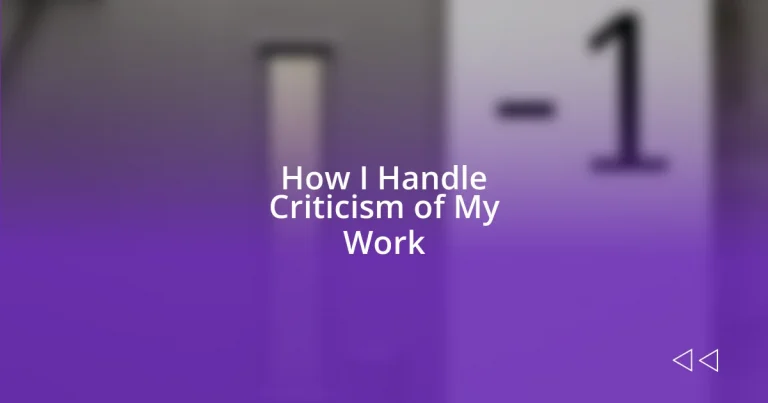Key takeaways:
- Criticism is subjective and can serve as a valuable tool for personal growth, prompting individuals to seek feedback rather than avoid it.
- Recognizing personal triggers and differentiating between constructive criticism and negativity enables a clearer approach to receiving feedback.
- Building resilience through intentional feedback-seeking and having a supportive network fosters a constructive perspective on criticism.
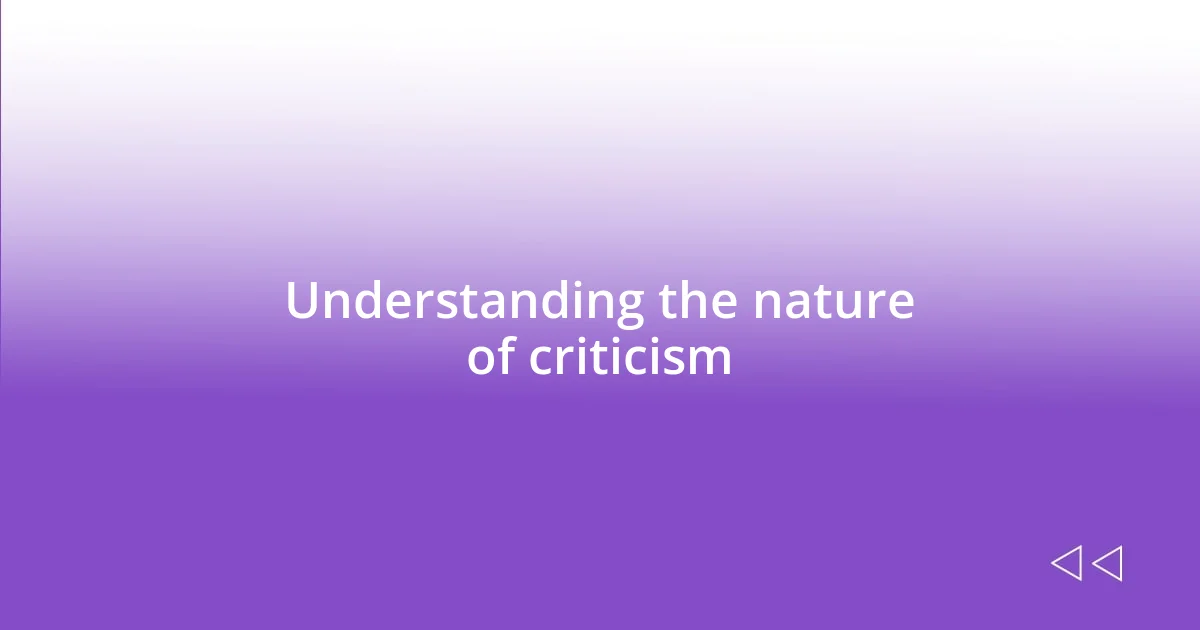
Understanding the nature of criticism
Criticism can sometimes feel like a punch to the gut, can’t it? I remember a time when I submitted a project I was really proud of, only to receive feedback that highlighted its flaws. At first, I felt defensive, but I soon realized that criticism is often a reflection of someone else’s perspective, not a judgment of my worth.
One of the most interesting aspects of criticism is how subjective it can be. For instance, I recall presenting an idea in a team meeting that I completely believed in, yet someone dismissed it without much thought. It stung at that moment, but it forced me to consider that criticism could be more about the critic’s experiences and biases than about my ideas. Isn’t it fascinating how our interpretations of feedback can shape our growth as individuals?
When I fully embraced the idea that criticism is a tool for learning, my perspective shifted dramatically. I began to seek out feedback instead of avoiding it—transforming my initial fear into curiosity. Have you ever found that the most valuable insights come from your harshest critics? To me, this shift opened up new avenues for improvement and made the creative process feel less isolating.
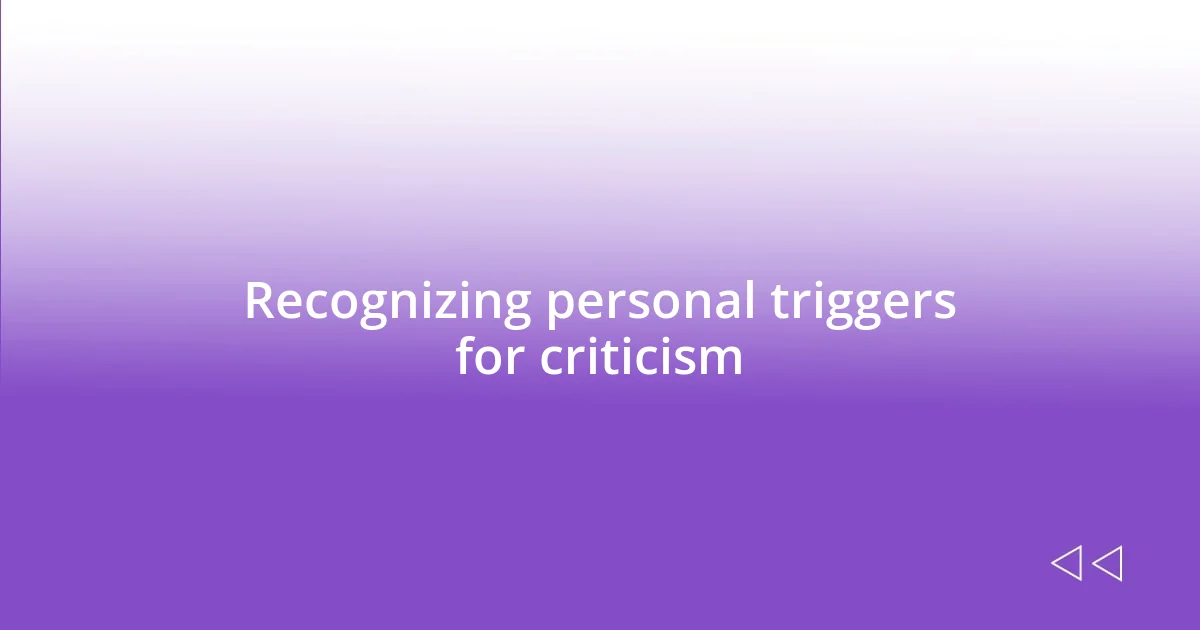
Recognizing personal triggers for criticism
Recognizing personal triggers for criticism is essential for growth, especially when feedback hits a sore spot. I’ve noticed that certain phrases or tones can put me on high alert, instantly making me defensive. For example, when feedback starts with “You should have…” I feel an immediate instinct to protect my choices, which often clouds my ability to absorb constructive comments. It’s these reactions that I’ve learned to pay attention to; recognizing them in the moment allows me to shift my focus from self-defense to understanding the feedback.
Here’s a quick list of common triggers I’ve identified in myself:
- Giving critical feedback in a group setting, which makes me feel exposed.
- Use of vague language, which leaves me confused about what I need to improve.
- Personal references, like “I thought you understood this,” that make me doubt my competence.
By becoming aware of these triggers, I’m better equipped to approach criticism with a clearer mind and a more open heart.
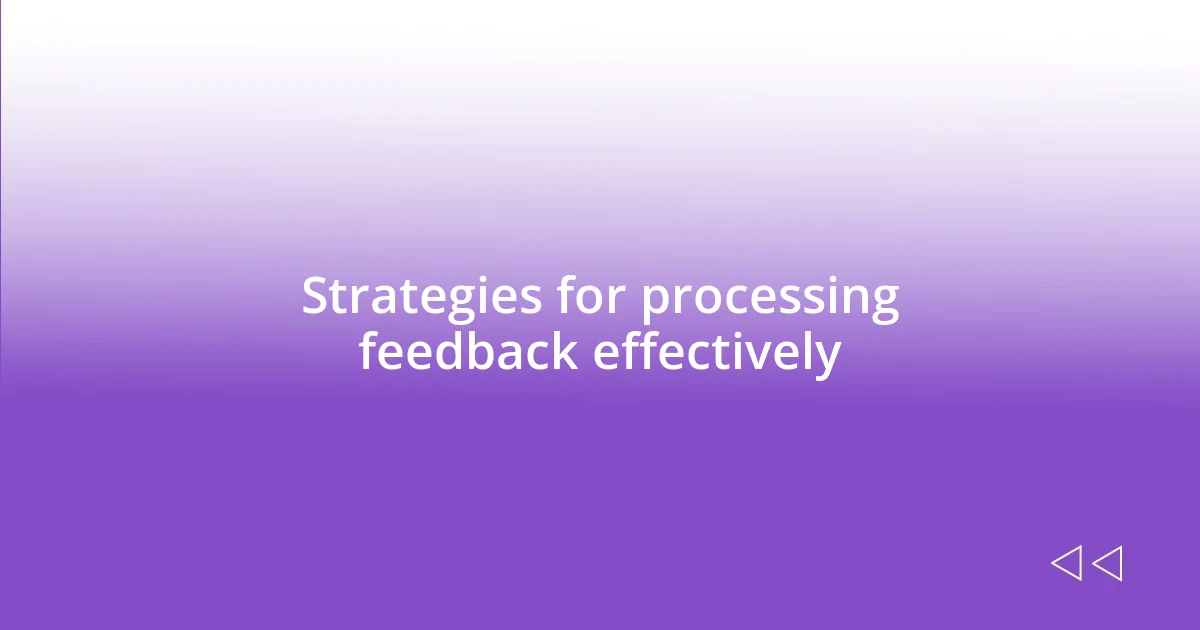
Strategies for processing feedback effectively
Processing feedback effectively can be transformative. One strategy I find incredibly useful is to pause and breathe before reacting to feedback. I’ve had moments when I felt a surge of emotion rise within me, wanting to respond defensively. Taking a step back allows me to sort through those emotions and consider the feedback without an immediate emotional response. It’s a simple yet powerful tactic that gives me the mental space to differentiate between personal feelings and constructive criticism.
Another approach I’ve adopted is to rephrase the feedback in my own words. This technique has helped me ensure that I fully understand the intention behind the comments. I once received feedback on a presentation that felt vague, but by articulating it back to the reviewer, I gained clarity and was able to tackle the specific areas of concern. It not only demonstrates my willingness to engage but also encourages a positive dialogue. Have you ever found that paraphrasing turns a potentially daunting conversation into a collaborative one?
Finally, maintaining a feedback journal has been invaluable in tracking my progress over time. I write down the feedback I receive, my reactions, and how I responded to the points raised. Reflecting on this over time, I noticed patterns in my work and my responses to criticism. This insight often guides me on what to focus on in future projects, transforming feedback from a challenge into a constructive journey of growth. Isn’t it amazing how such a simple practice can shift your perspective on criticism altogether?
| Strategy | Description |
|---|---|
| Pause and Breathe | Take a moment to calm your emotional response before addressing feedback. |
| Rephrase Feedback | Articulate the feedback in your own words to ensure understanding and extend the conversation. |
| Feedback Journal | Document and reflect on feedback to track your growth and identify patterns. |
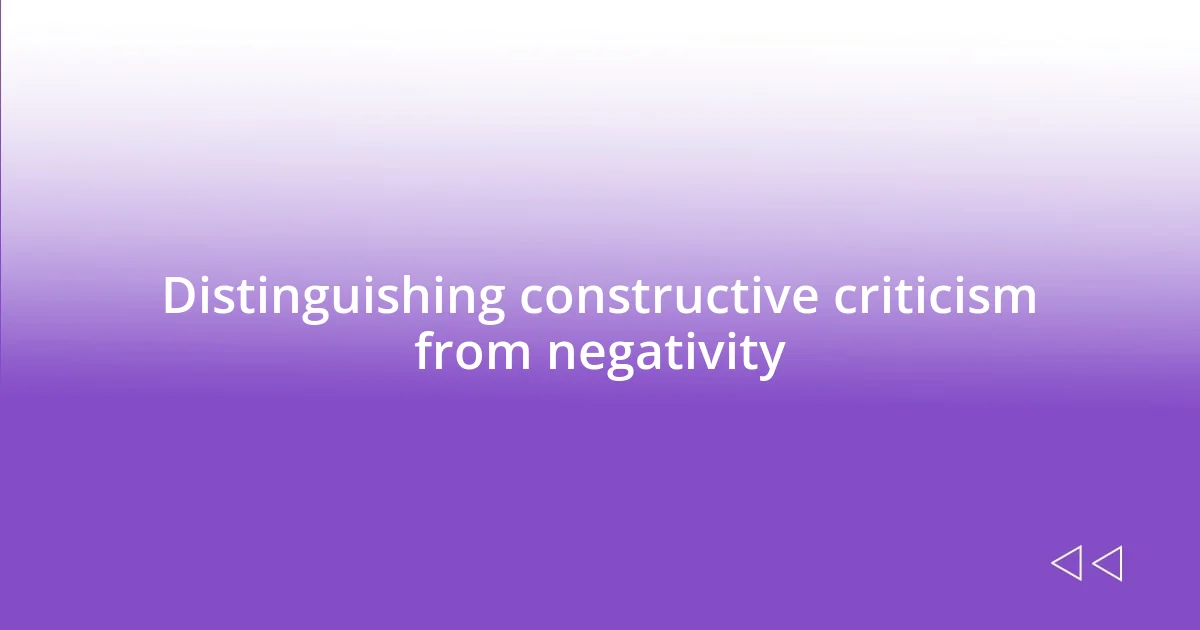
Distinguishing constructive criticism from negativity
Understanding the difference between constructive criticism and negativity has been a journey for me. I remember a specific instance when a colleague’s feedback felt harsh. Their comment—“You make too many mistakes”—landed like a punch in the gut. In that moment, I had to ask myself: Was this person trying to help me improve, or were they just venting their frustration? I soon realized that constructive criticism is usually accompanied by specific suggestions for improvement, while negativity often lacks clarity and comes off as a personal attack.
I find it helpful to look for intentions behind the words spoken. When someone offers constructive criticism, they often convey a desire to see me grow and succeed. Conversely, I’ve noticed that negativity feels more like a dismissal of my efforts. For example, I received feedback about a project where the reviewer not only pointed out flaws but also highlighted what I did right. That balance made me want to learn more. It’s a reminder that not all feedback is created equal, and recognizing that can change how I receive it.
Another aspect I pay attention to is the tone and delivery of the feedback. I’ve observed that constructive criticism often promotes an open dialogue, inviting further discussion. A few months back, during a workshop, a facilitator offered pointed feedback but also asked, “What do you think about this approach?” This question turned a moments of disappointment into a productive exchange where I could reflect and engage. So, next time you receive criticism, ask yourself: Does it leave you feeling empowered to improve, or does it weigh you down with doubt? That distinction can significantly affect how you move forward.
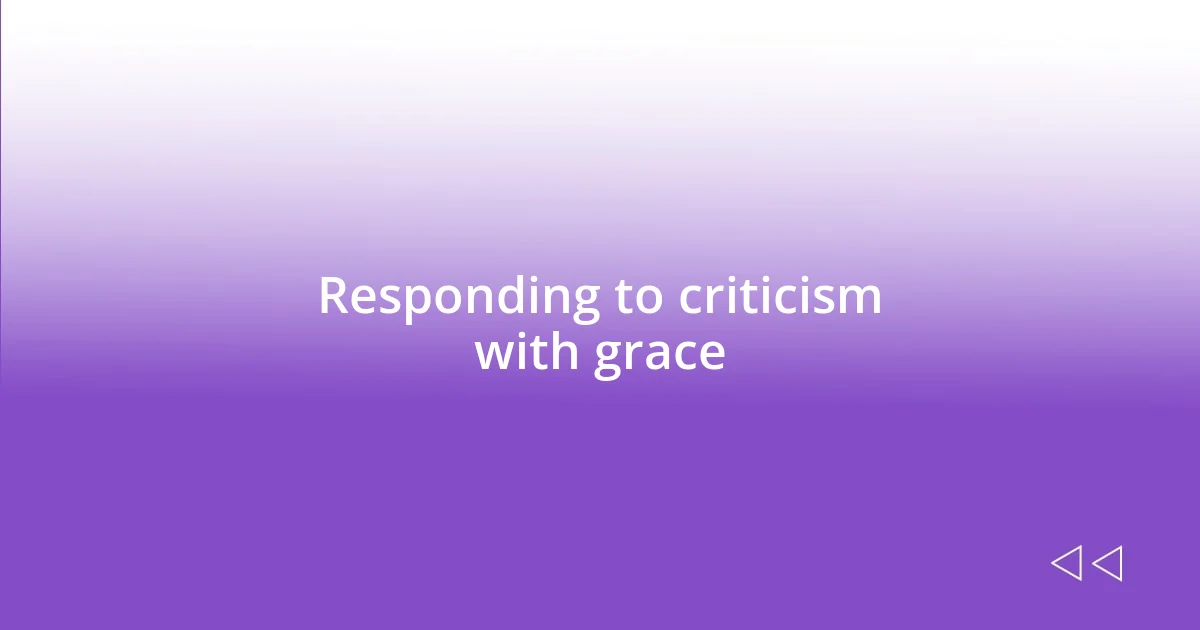
Responding to criticism with grace
Responding to criticism gracefully requires a mindset shift. I remember one particularly challenging moment when my manager critiqued a project I poured my heart into. Instead of letting frustration bubble up, I took a breath and reminded myself that her intention was to help me grow. This realization transformed the conversation into an opportunity rather than a confrontation.
Another useful tactic I employ is to express gratitude for the feedback. It might sound counterintuitive, especially when the comments sting, but a simple “Thank you for pointing that out” can diffuse tension. I learned this during a review meeting where a colleague pointed out flaws in my work. Acknowledging their input not only eased my initial defensiveness but also opened the door for a more constructive dialogue. Doesn’t it feel more collaborative when you approach feedback with appreciation?
Lastly, I’ve found that maintaining a calm and positive demeanor can influence how the feedback is received. I recall a situation where I received critical feedback from a client, and rather than reacting emotionally, I chose to smile and engage. This approach not only helped me to absorb the critique more effectively but also reassured the client that their concerns were valued. How I respond often sets the tone for future interactions, so I strive to respond with grace and openness.
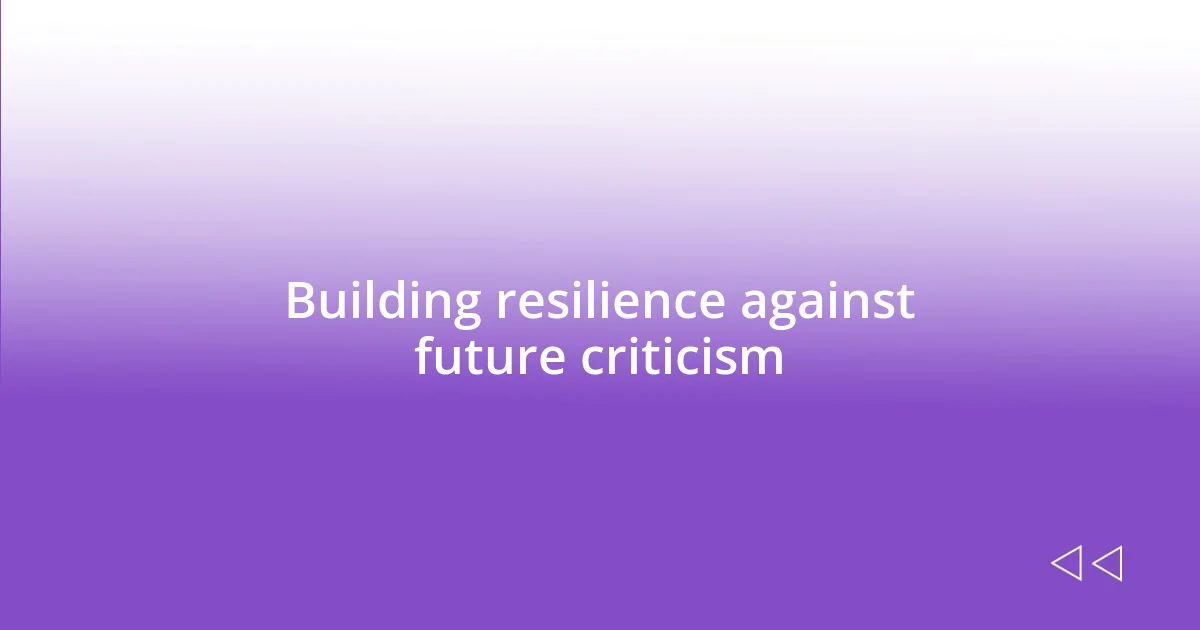
Building resilience against future criticism
Building resilience against future criticism requires a proactive approach. I recall an incident after showcasing a project I was proud of, only to receive feedback that pulled me down. Instead of sulking, I decided to reflect on what I could learn from it. I started keeping a journal, noting down the feedback I received and identifying patterns. This not only helped me see recurring themes but also transformed my perspective towards criticism, making it feel less like a personal attack and more like a stepping stone toward improvement.
Another strategy I’ve embraced is seeking out feedback intentionally. By asking colleagues for their thoughts on my work before it goes public, I’ve created a space where criticism becomes part of the creative process rather than an afterthought. I was surprised by how empowering it felt to invite criticism; it shifted the control back to me and diminished the fear of unexpected negative comments. Wouldn’t you agree that actively seeking feedback prepares us to handle future critiques more constructively?
Additionally, I’ve found it invaluable to build a support network of peers who understand the challenges of our work. After a particularly tough review, I reached out to a trusted friend who had experienced similar situations. We discussed our feelings and strategies for handling criticism, which not only uplifted my spirits but also filled me with practical insights. Surrounding myself with understanding voices reassures me that criticism is a common hurdle, not an isolated battle. How can we learn to transform criticism into a source of strength? By recognizing that we’re not alone in this journey, resilience becomes not just a goal, but a shared experience.












